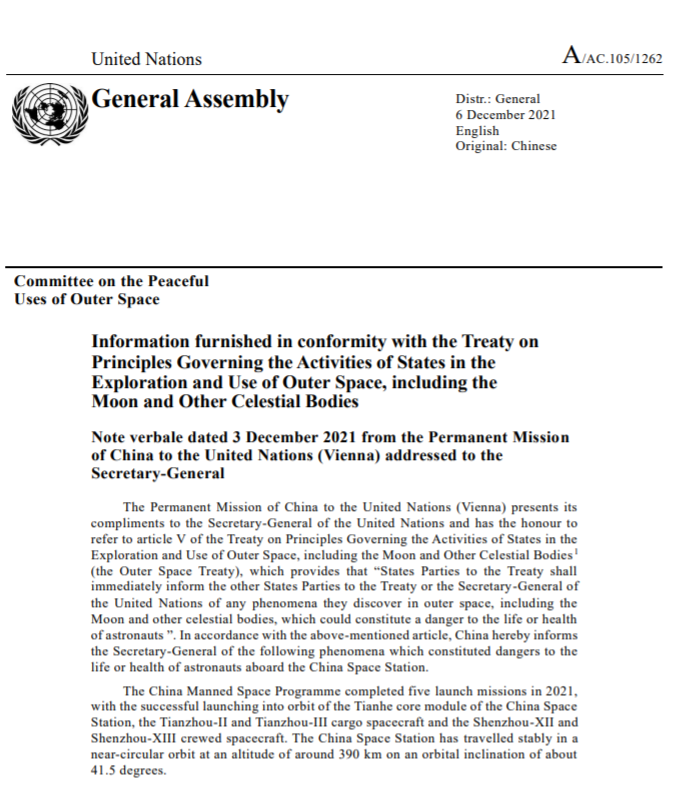2022年6月1日,中国科学院自然科学史所副研究员张志会受邀在国际知名政策研究平台东亚论坛(East Asia Forum)发表题为 “Avoiding a collision course over space privilege ”(《避免空间权限冲突》)的英文评论文章,对2021年美国“星链”卫星两次险些撞上中国空间站的事件进行了评论。作者指出,在人类共有的太空轨道上,各方都应遵守“交通规则”,避免在太空中横冲直撞。加强信息公开和风险管理,增强各方在太空安全方面的合作,符合中美两国乃至全人类在太空中的共同长远利益。(后附文章原文,本文经作者重新补充修订。)
撰文 | 张志会(中国科学院自然科学史所副研究员)
2021年4月29日中国空间站天和核心舱顺利发射升空。中国2021年12月6日向联合国写的一封投诉信显示,依据《外层空间条约》(Outer Space Treaty)第五条条款,“条约缔约国应立即将其在外层空间,包括月球和其他天体中发现的可能危及宇航员生命或健康的任何现象通知条约其他缔约国或联合国秘书长”,中国特通知秘书长美国以下威胁中国空间站宇航员生命或健康安全的现象[1]:2021年,美国埃隆·马斯克(Elon Musk)的太空探索技术公司(SpaceX)发射的两颗“星链”(Starlink)卫星分别从500公里和555公里的近地轨道突然下降,与正在约390公里近圆形轨道上稳定运行的中国空间站进行了两次近距离接触。
2021年5月16日至6月24日,星链卫星-1095卫星连续运行至382公里左右的轨道,然后停留在该轨道上。2021年7月1日该卫星与中国空间站发生了近距离接触。10月21日,星链卫星-2305一直自主运动,且运动策略未知,轨道误差难以评估。当时中国空间站搭载了我国三名宇航员,一旦发生意外后果不可设想。出于安全考虑,中国空间站分别于2021年7月1日和10月21日实施了预防性紧急处理,改变空间站“天和”核心舱的运动轨道,以避免和星链卫星的碰撞。中方作为负责任的太空大国,愿请联合国向外层空间条约所有缔约国分发上述信息,并提请它们注意。对美方这种罔顾中国空间站及正在太空中执行任务的宇航员的安全的行为,中方外交部表示了强烈谴责。
 图:中国就星链卫星两次险些撞上中国空间站,向联合国提交的文件
图:中国就星链卫星两次险些撞上中国空间站,向联合国提交的文件
关于事件发生的原因,有四种主要猜测及相关解释。第一种是SpaceX公司在其星链卫星寿命结束时,主动降低这些卫星的轨道高度,让其脱离轨道。2019年,一颗星链卫星在测试自动脱轨技术后,就曾险些与欧洲航天局的一颗气象卫星相撞。第二种解释是SpaceX降低星链卫星的轨道,以缩短星地通讯延迟,从而促进星链卫星系统达到当初宣称的全球网络通讯的预定目标。第三种解释是星链卫星发生失控,这在此前已有先例。还有一种解释是,这是一种授命于美国军方的蓄意空间测试。
无论出于何种原因,美国都不应以“公司行为”为借口,推卸其作为《外层空间条约》签署国对SpaceX公司行为的责任。根据该条约第六条规定,“条约缔约国应对本国在包括月球和其他天体在内的外层空间的活动承担国际责任,无论这些活动是由政府机构还是非政府实体进行的,并应确保本国活动的开展符合本条约的规定”。美国一直宣称所谓的“负责任外空行为”概念,自己却无视外空国际条约义务,对中国航天员的生命安全造成严重威胁,这是典型的双重标准。中国给联合国的照会提醒世人,美国需要成为一个负责任的太空大国。
在联合国的点名下,美国终于在2022年初提交给联合国一份照会。美国在照会中声称,经过数据估算后发现,由于星链卫星的自动规避系统,与中国空间站碰撞的可能性并不大,而且星链卫星具备自动避碰能力。中国对该说法的有效性提出了质疑:星链卫星在拥有自动规避系统的情况下,为何还会近距离接近中国空间站?星链卫星系统提前为单个卫星设置的避碰机动机制,反而可能导致连锁反应,增加卫星系统的总体碰撞风险。美国所谓的既定紧急碰撞标准又是多少?而且,美国方面为何迟迟不做出正面回应?除了增加航天器碰撞的风险外,星链卫星在近地轨道上“横冲直撞”的行为还威胁到了来自日本、美国、俄罗斯和中国的宇航员的安全。正如中国外交部发言人所说,美方应该尊重以国际法为基础的外空国际秩序,采取措施防止此类事件再次发生。
“星链”计划的主要目的之一是赤裸裸地攫取近地轨道资源,即在距离地球半径约三分之一的高度上的自由空间内的轨道资源。在中美科技竞争的大背景下,美国在5G方面落后于中国,早早启动了6G通信技术的研发,卫星通信和近地轨道资源是其重要支撑。SpaceX公司依仗其商业公司身份及其掌握的可回收火箭、一箭多星的技术优势,以低成本批量持续大批向500公里轨道高度发射和部署廉价卫星,其理由是加速太空探索和为全球消费者提供廉价、快速的宽带互联网服务这一“公共福利”,但是SpaceX的星链卫星技术尚未完全成熟,这本身即是非常不负责任的行为。
SpaceX公司已经征得了美国联邦通信委员会(Federal Communications Commission,FCC)的许可,被允许将多达12000颗星链卫星送入轨道。现在SpaceX正在继续征求FCC的许可,计划向近地轨道发射30000颗下一代星链卫星,两代卫星将共计42000颗。这些卫星将占用大部分近地轨道资源。在不远的将来,其他国家可能不得不花费大量资金来购买SpaceX占用的近地轨道资源。如果该公司以保护商业机密为借口,拒绝出售其近地轨道资源或拒绝披露改变其星链卫星变轨计划的相关信息,情况将会进一步恶化。SpaceX野心勃勃的计划甚至也引发了美国国家航空航天局(NASA)的反对和批评。
第三种猜测是,星链卫星这一离奇行为潜藏着不可告人的军事目的,毕竟马斯克及SpaceX公司短期内不太可能通过星链卫星在民用领域获得回报。表面上看,星链公司是由马斯克的私人公司SpaceX而非军方所有,这一理论不太可能成立。但种种证据和迹象表明,这次的“险些碰撞”事件可能是SpaceX公司按照美国军方命令实施的一次特殊的空间实验。
从人类进入太空时代开始,美国就把外太空视为美国必须控制的战略领域。2018年7月,模拟的星链网对多达350枚洲际弹道导弹的弹头进行了成功拦截,但是近地轨道超音速武器仍有望成为中国撕开美国军事霸权的重大突破口。2021年,中国率先成功研制可在近地轨道运行的超高音速导弹,美军现有的导弹防御系统还无法完全拦截它,这无疑加大了美国的忌惮。然而,当美国担心其军事霸权受到严重威胁时,SpaceX公司具有强大军事潜力的星链卫星计划开辟了一条新的道路。SpaceX 公司的部分发射场租用的是美军范登堡空军基地,这可让部分星链发射的绝密计划免于审查。星链计划开展的技术验证测试包含在卫星与空军战斗机之间进行机密互连的相关内容。2019年,SpaceX公司获得美国空军的资助,用于测试星链卫星和军用飞机之间的加密互联网服务。2020年5月,美国陆军与SpaceX公司签署协议,测试星链宽带在跨军事网络数据传输中的使用。2020年10月,SpaceX公司赢得了一份价值1.5亿美元的合同,用于开发军用版本的星链计划。
从结果上看,最新的“星链”事件将进一步增强中国的太空防御意识,这可能引发北京和华盛顿之间争夺近地轨道资源的太空竞赛。在过去几年中,中国一直在尝试将早期的“行云”、“虹云”、“鸿雁”等卫星星座计划共约600颗卫星,整合到一个国有卫星通信网络中。虽然从现有规模来看,中国的卫星星座计划的规模还远远小于星链计划,但是,中国自然也不会甘心日后受制于人而不预先采取任何应对措施,更毋宁说极其重要的近地轨道资源。中国更多的民营企业的竞争力正显著提升,华为公司已提出了自己的卫星组网计划,深蓝公司在火箭回收技术上取得了突破,这些都将大大降低中国近地轨道上部署卫星的成本,并提高了布局速度。中国2022年再次明确提出要建设天地一体的信息基础设施,以整合现有的空间资产、移动网络和未来的电信。
面对国际上对近地轨道资源的激烈竞争,需要采取明确的制度措施,确保中国、美国和私人利益相关者能够合作实现空间安全:
各国应加强对全球低地球轨道资源的管理。应设立一个专门的联合国机构,以修订空间资源“先到先得”原则。还应部分限制企业和机构通过无限制地发射大规模卫星,对近地轨道资源进行任意占领。应对威胁宇航员安全的公司企业和负责人列入谴责名单,并规定适当的经济制裁。
私人空间公司有义务维护“空间秩序”。美国国家航空航天局(NASA)于2022年2月表达了其对SpaceX提案的担忧,例如大量发射卫星可能增加星链卫星与其他太空物体之相撞的概率,也可能干扰到其他卫星和地面科学,但SpaceX却没有采取任何措施来改善星链卫星的自动避碰机制,以及其他相关的可持续性的安全措施。对此,各国应加强共同风险管理战略甚至国际性管制措施,保持航天设施的稳定运行,以督促和迫使私营航天公司避免这些事件,重塑中美航天竞争格局。
空间各方利益相关方应制定外层空间国际合作准则。这些普遍准则应提及一套操作说明,阐明一国航天器在接近另一国航天器时的义务,包括及时预测碰撞风险、披露必要信息和与其他空间机构积极沟通。
太空探索是一项高风险的技术挑战,美国遵守这些规则将有助于促进中美在空间安全领域的合作。在共同空间轨道上,各方应遵守“交通规则”,避免在太空中横冲直撞。加强信息公开和风险管理,尽力增强各方合作,不仅符合中美两个太空大国,也符合全人类的共同长远利益。
The post Avoiding a collision course over space privilege first appeared on East Asia Forum
Wed, 01 Jun 2022 00:00:55 +0000
Author: Zhihui Zhang, Chinese Academy of Sciences
The core module of the China Space Station (CSS) was launched into space in April 2021. In July and October 2021, two SpaceX Starlink satellites suddenly dropped from a low earth orbit of 500km and 555km, respectively, into the CSS’s path. The CSS made an emergency manoeuvre to avoid a collision. China condemned the United States at the United Nations, claiming the incident threatened the CSS and its astronauts.
There are two popular explanations as to why the incident occurred. One is that it was an accident, as SpaceX actively deorbits its satellites at the end of their lives. A Starlink satellite nearly collided with a European Space Agency’s meteorological satellite in 2019 after testing its automatic deorbiting technology. The alternative explanation is that it was a deliberate act by the US military.
Whatever the reason, Washington should not use the pretext of ‘corporate behaviour’ to shirk its responsibility for the actions of SpaceX as a signatory of the outer space treaty.
China’s note to the UN is a reminder that the United States needs to be a responsible space power. In a submission to the UN in 2022, Washington claimed that the possibility of a collision was tiny because of Starlink’s automatic evasion system — the efficacy of which has been questioned by China. Besides increasing the risk of spacecraft collision, the irresponsible behaviour of Starlink satellites in low earth orbit also threatens the safety of astronauts from Japan, the United States, Russia and China.
Starlink is a plan to seize low earth orbit resources as one of its main objects. Relying on recyclable rockets and its ability to launch multiple satellites with one rocket, SpaceX has launched cheap satellites, whose technology has not fully matured, in low-cost batches justified by the ‘public welfare’ gained from having access to high-speed broadband internet. The US Federal Communications Commission has granted SpaceX permission to fly 12,000 Starlink satellites.
SpaceX plans to send up to 42,000 Starlink satellites into low earth orbit, most likely taking up over 80 per cent of low earth orbit resources. Other countries may have to spend a great deal of money to buy low earth orbit resources occupied by SpaceX in the future. The situation will deteriorate should the company refuse to sell its resources or refuse to disclose plans to change their satellites’ orbits under the pretext of protecting trade secrets.
This bizarre incident may have hidden military purposes. Some launch sites are built in Vandenberg Air Force Base of the US, and the technical verification test is included in the content of confidential interconnection between satellites and Air Force fighters. In 2019, SpaceX received funding from the US air force to test the encrypted Internet services between the Starlink satellites and military aircraft. In May 2020, the US Army signed an agreement with SpaceX to test the use of Starlink broadband for cross military network data transmission. In October 2020, SpaceX won a $150 million contract to develop a military version of the Starlink.
The latest Starlink incident will further enhance China’s awareness of space defence — potentially triggering a space race between Beijing and Washington to seize low earth orbit resources. China has over the last few years been trying to integrate earlier satellite constellations (around 600 satellites) into a state-owned satellite communication network on a scale far smaller than the Starlink plan.
Private enterprises are improving their competitiveness, with Huawei’s satellite networking plan and Deep Blue Aerospace’s breakthrough in rocket recovery technology changing the industry. China proposed its own ‘Space-Ground Integrated Information Network’ in 2022 to integrate existing space assets, mobile networks and future telecommunications.
Facing fierce international competition for low earth orbit resources, institutional measures need to be taken to ensure that China, the United States and private stakeholders can cooperate to achieve space security.
Countries should strengthen the management of global low earth orbit resources. A specialised UN agency should be created to revise the previous ‘first come, first served’ principle for space resources. They should also partially restrict the arbitrary occupation of low earth orbit resources that occurs when enterprises and institutions launch massive satellites without constraints. Those responsible for threatening the safety of astronauts should be included in a list for condemnation — with provisions for appropriate economic sanctions.
Private space companies should be obligated to uphold the ‘space order’. NASA outlined its concerns about the SpaceX proposal in February 2022, yet nothing was done to improve the satellite’s faulty automatic collision avoidance mechanism. In response to this, countries should strengthen shared risk management strategies and maintain the stable operation of space facilities to help private space companies avoid these incidents and reshape the Chinese–US space competition.
Space stakeholders should formulate guidelines for international cooperation in outer space. These universal guidelines should refer to a set of operational instructions clarifying the obligations of one country’s spacecraft when approaching another country’s spacecraft — including the timely prediction of collision risk, disclosure of necessary information and active communication with other space agencies.
Following these regulations will help promote Chinese–US cooperation in space security. In common space orbit, all parties should abide by the ‘traffic rules’ and refrain from rampaging through space.
Zhang Zhihui is Associate Professor at the Institute for History of Natural Sciences at the Chinese Academy of Sciences.
The post Avoiding a collision course over space privilege first appeared on East Asia Forum.
(Source : )
作者简介

张志会,哲学博士,现任中国科学院自然科学史所副研究员,近年来主要研究当代中国空间科学史、中美航天科技交流史。曾受中科院或国家留学基金委资助到美国加州理工学院、科罗拉多矿业大学、密歇根理工大学担任访问学者,并在美国史密森学会(Smithsonian Institution)资助下到美国航空航天博物馆航天史部访问研究。独立撰写的学术著作2部,在《Space Policy》《History of Geo- and Space Science》等SSCI来源期刊发表第一作者和通讯作者论文 5 篇;受邀撰写英文著作章节 4 篇。在《自然科学史研究》《当代中国史研究》等国内核心期刊共发表论文50余篇,国际一流期刊多篇书评。 多篇学术论文产生较好学术影响,4篇被《新华文摘》全文转载,1篇被《中国社会科学文摘》全文转载。
参考资料
[1]
0
推荐




 京公网安备 11010502034662号
京公网安备 11010502034662号 